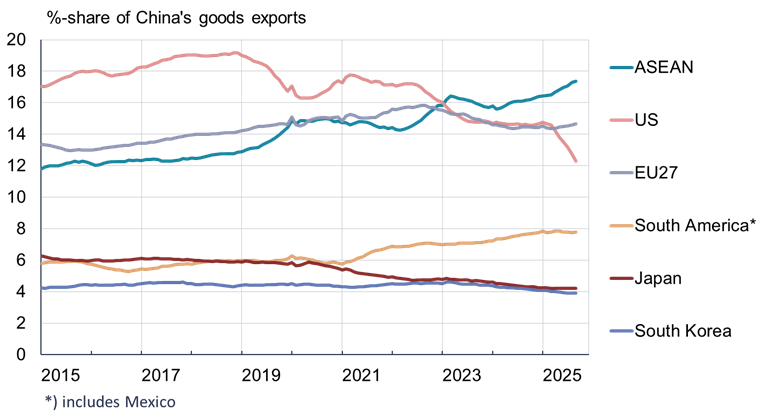BOFIT Weekly Review 42/2025
China’s exports increased in September, but trade tensions with the United States have again intensified
The value of China’s goods exports increased in September by 8 % y-o-y to $330 billion. For the first nine months of this year, the value of Chinese exports was 6 % higher than in the same period last year. Moreover, imports, which had been sluggish during the first half of the year, were also up in September by 7 % y-o-y, climbing to $238 billion. For January-September, however, the value of imports was still down by 1 % from a year earlier.
Chinese exports to the US have declined substantially this year. Prior to the tariffs announced in 2018 and 2019 during Trump’s first term, the US accounted for 19 % of Chinese exports. By September of 2025, that share had sunk to 12 %. China’s third-quarter goods exports to the US (measured in dollars) were down by 27 % y-o-y. In actuality, however, US consumption of Chinese products has not decreased as much. Over the years, China has learned to circumvent high tariffs through such strategies as relocating assembly plants and value-added processes to third countries that enjoy lower US import tariffs. For example, China’s goods exports to ASEAN countries in the third quarter rose by 18 % (of which to Vietnam by 27 %), and to Taiwan by 16 %. Our recent policy brief also notes that US goods imports from Vietnam and Taiwan, among others, have soared.
Despite a partial truce, the trade war between the United States and China escalated again in October. China announced new export restrictions on rare earth metals (REEs), starting from December 1, as well as restrictions on battery technology exports from November 8. REE restrictions particularly target certain magnets and materials that are also manufactured abroad using Chinese raw materials or technology. The export restrictions on battery technology focus on advanced batteries used in defence, aerospace and energy storage, as well as critical battery materials where China dominates global production. Companies must now apply for export licences from China’s Ministry of Commerce (MOFCOM). Based on earlier experience, officials can strategically slow the processing of licence applications and thereby create supply chain delays or disruptions.
With the announcement of the new export restrictions, president Trump threatened to again impose a 100 % tariff rate on China, along with export restrictions on critical software effective November 1, triggering a strong negative market reaction. Trump’s subsequent statements on the matter were more measured. A few days later, China announced sanctions against five US subsidiaries of South Korean shipbuilder Hanwha Ocean, further escalating tensions ahead of planned trade talks. On October 14, the two countries started charging new port fees on each other’s vessels. The US had already earlier announced new port fees for ships associated with China as part of an effort to reduce China’s influence in global shipping and strengthen the US shipbuilding industry. China responded by imposing its own port charges on US-linked vessels the same day the US charges went into effect. The US and Chinese presidents are still scheduled to meet in South Korea at the end of this month. The postponement of higher import tariffs on China, announced by the US, ends on November 10.
The US share of China’s goods exports shrank dramatically over the course of this year

Sources: China Customs, Macrobond and BOFIT.